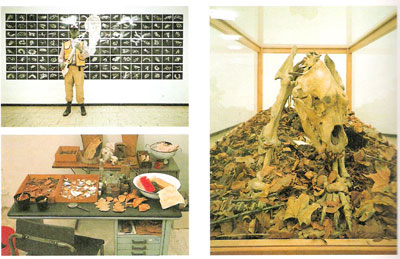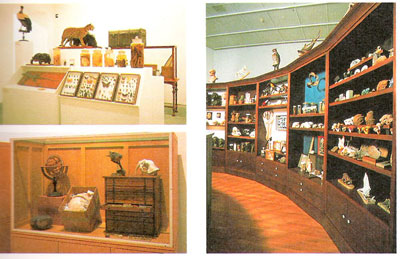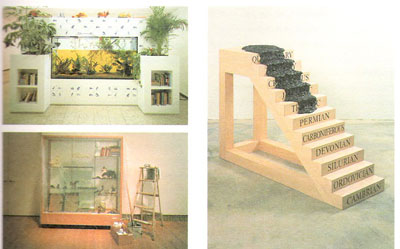|
MARK DION'S "CHAMBER
OF CURIOSITIES"
Takayo Iida
In early September 2002, Mark Dion could be seen at the Tsukiji Fish
Market in the busy throng surrounding the fish sellers chopping up freshly
caught tuna. A symbol of Tokyo's huge stomach, Tsukiji Market has a powerful
impact on the visitor. The order and chaos, pace, noise and dynamic movement
of people and goods encapsulate the energy and diversity of Japan's capital
city. Visiting Japan to do field research for this exhibition, Dion was
fascinated by the spectaele. Conceived as a metaphor and symbol of the
Tokyo megalopolis, this project will be conducted in the Koishikawa Annex
of the University Museum of the University of Tokyo. Together with student
volunteers, the artist will collect the unique "garbage"generated in the
"magnetic field" of the campus of the University of Tokyo. The artist
will select items from the vast array of materials and objects, such as
medical specimens, belonging to the University Museum and the university
research laboratories. These objects will then be exhibited together with
the "garbage" under exactly the same conditions. Since the volunteers
and collaborators for this project are students of the university and
teaching staff of the University Museum, the guidance and collaboration
provided by the museum to support the artist's activities will form the
nucleus of the exhibition. This is also a uniquely challenging project
that reveals the chronological phases concealed within these proliferating
objects and the "baroque beauty" that has been obscured by existing values,
while topologically traversing the city of Tokyo within a natural historical
context. The Tsukiji Fish Market, one of the magnetic fields which attracted
Mark Dion when he came to Japan to do field research, is itself a living
system of wonders that reflects Tokyo's dynamism and confusion. If we
view the functions of the city as a metaphor for the human body itself
and Tsukiji as one of its organs, another topological space comes into
relief. This is the Wunderkammer, the "museum within a museum" set up
for this exhibition. Divided into eight thematic compartments -The Realm
of Air, The Underworld, The Realm of Water, The Terrestrial Realm, Humankind,
Reason and Measure, The Gigantic, and The Miniature -it reflects the many
faces and vital functions of the Tokyo megalopolis.
Mark Dion was born in New Bedford, Massachusetts in 1961 and is currently
based ln New York.lt would be no exaggeration to say that Dion the artist
was a product of the environment of his native New Bedford. New Bedford
boasts the world's biggest whaling museum, containing many exhibits relating
to John Manjiro(1827- 1898), a Japanese fishermen who was rescued by an
American whaling vessel in 1841 and lived in America for 10years. As a
youth growing up in New Bedford, Diorn visited the whaling museum and
industrial museum many times and drew much inspiration from them. Collecting
shells was one of his boyhood passions. Needless to say, these early experiences
form the foundations of his current activities as an artist. For one year
from 1984, Dion studied under the independent Study Program at the Whitney
Museum of American Art, which has produced many of America's leading contemporary
artists. While working as an assistant to Ashley Bickerton, he had the
opportunity to coolly observe the contemporary art scene. In 1987, he
took part in the Dokumenta 8 international exhibition in Kassel, Germany.
Since 1990 he has done various fieldwork relating to environmental problems,
and his art works are usually the results of this fieldwork. He has given
exhibitions in Holland, Germany, France and Eastern Europe, where he has
completed many projects while conducting field research together with
local environmental conservation groups and volunteers.
What is the wellspring of Mark Dion's diverse creative activities ? In
order to determine the origin and background of the underlying philosophy
and methodology of Dion's projects, I will here attempt to throw light
on the unique creativity of his works, with reference to the artists who
have had a particularly strong influence on him. These artists include
Joseph Beuysz who produced works in a wide variety of genres, such as
paintings, installations and performances on the theme of "art and socIety,
"merging the conflict between ecology and environmental problems into
folk mythology; Robert Smithson, a pioneer of the genres of Earthwork
and Land Art who explored from the standpoint of entropy the principles
underlying dualisms such as "order and chaos" and "nature and artifice";
Joseph Cornell, who created various microcosmoses through collages of
celestial maps, constellations and musical scores using a box format as
his medium of expression; and Gordon Matta-Clark, who literally deconstructed
abandoned architectural structures to create new spaces. Mark Dion himself
has stated that the above artists, sadly no longer with us, had the greatest
influence not only on his works but on the way he lived. Among currently
active artists, Hans Haake, Tom Burr Ericson & Ziegler, and Jason Simon
have strong philosophical affinities with Dion, while Alexis Rockman,
Gregory Crewdson and Bob Braine share the same methodological approach.
Mark Dion has even arranged these various contemporary artists in one
of his own Wunderkammer, a "treasure chest" of the people that have inspired
his work. In this Wunderkammer the artist freely transcends time frames,
expressing history in the form of a loop rather than the linear succession
of past, present and future. The Hapsburg emperors from the sixteenth
to the seventeenth centuries -Ferdinand l, Maximilian ll, Grand Duke Ferdinand
and Rudolf ll -were all avid collectors. The display rooms they had built
in their palaces were museums known as Kunst- und Wunderkammern in which
they collected objects of "wonderand bizarre beauty." This is the origin
of the word Wunderkammer, the title of this exhibition. The contents of
the Wunderkammer are described by Tatsuhiko Shibusawa in his book Cosmographia
Fantastica: "This museum in the shape of a terrifying devil's mask contained
all kinds of mysterious objects collected from all over the world, arranged
within a very small space. The exhibits included strangely-shaped glass
vessels, jewel jars, tiny sculptures made of ebony, alabaster or serpentine,
ancient musical instruments, mechanical dolls, mummified animals, ancient
animal bones, deformed creatures pickled in alcohol, weird plants, shells
from the South Seas, mineral specimens, optical instruments, celestial
globes, suits of armor, books on witchcraft prayer books, musical boxes,
pisotols, skulls, and so on."
Mark Dion has his doubts about the conventional approach of museums.
The museum has not escaped the influence of the modernist thought that
has permeated society at every level since the eighteenth century. The
objects that filled the Wunderkammer-style museums, which inspired feelings
of curiosity and excitement in the viewer, were rapidly classified and
put in order, to the extent that museums also came to be viewed as "graveyards."
In the field of contemporary art, public art museums struggling due to
lack of funds tried to attract visitors by setting up easy-to understand
exhibition programs that treated viewers like children. In this way, museums
are ceasing to be spaces for programs and modes of expression that draw
attention to various social problems and question the significance of
art. In short, the art museum seems to be turning into a kind of "leisureland."
According to Dion, "A museurn should provoke questions, not spoon-feed
answers and experiences. I'm excited by the tension between entertainment
and education in the idea of the marvelous, especially in pre-Enghtenment
collections like curiosity cabinets and Wunderkammers."
In 1999, Mark Dion conducted a project called the "Tate Thames Dig" by
the River Thames in London together with volunteers, most of them teenagers
from the local community. In this project, the participants applied an
archeological approach to pieces of garbage washed up by the tide or thrown
away on the banks of the river, excavating, cleaning and then classifying
them. The objects thus classified ranged from bones of animals, sea shells,
driftwood, pottery and glass bottles to debris of the consumer society
such as mobile phones, credit cards and microchips. These "chronological
layers" dating back to before the twentieth century were exhibited at
the Tate Gallery. They represented an intriguing reversal of values: the
"garbage" that had accumulated over the centuries had become "treasure,'
while formerly valuable waste products consumed by contemporary society
had turned into garbage! Collaborating with researchers from fields such
as history, cultural anthropology, scence and biology. Dion has made these
projects into his works through fieldwork, workshops and lectures on the
relationship between cities and nature, focusing on themes such as the
relationship between modern cities and ecology, the extinction of species
through environmental pollution and destruction and the question of evolution/
devolution. Through this work, he has gained an international reputation
not only as an artist but also as a social activist. By transcending his
idenntity as an artist, Dion has made art accessible to a wide variety
of people with the ultimate aim of stimulating the revitalization of the
urban community from the perspectives of history and sociology.
Locatingthe origins of the museum in the border region between art and
natural science, Mark Dion has in effect pursued his work as an artist
while devlating from the genre of contemporary art. An exhibition of his
work is therefore replete with possibilities for discovering new appeal
and vitality not only in the museum but also in the role that art can
play in society. Urban-concentrated mass consumer society has now reached
a critical point where we are saturated with simulacra with no relation
to reality and a swelling flood of information disseminated by the Internet
under the banner of globalization. Mark Dion owns neither a computer nor
a mobile phone. Rather than simply rejecting virtual networks, however,
he is reminding us of the importance of stepping back from values of contemporary
society such as speed, precision and virtual reality and devoting ourselves
to the reassessment of these values. Through this "archaeology of knowledge,"
he is attempting to give us a glimpse of a model for future society.
(Exhibition Curator)
|



